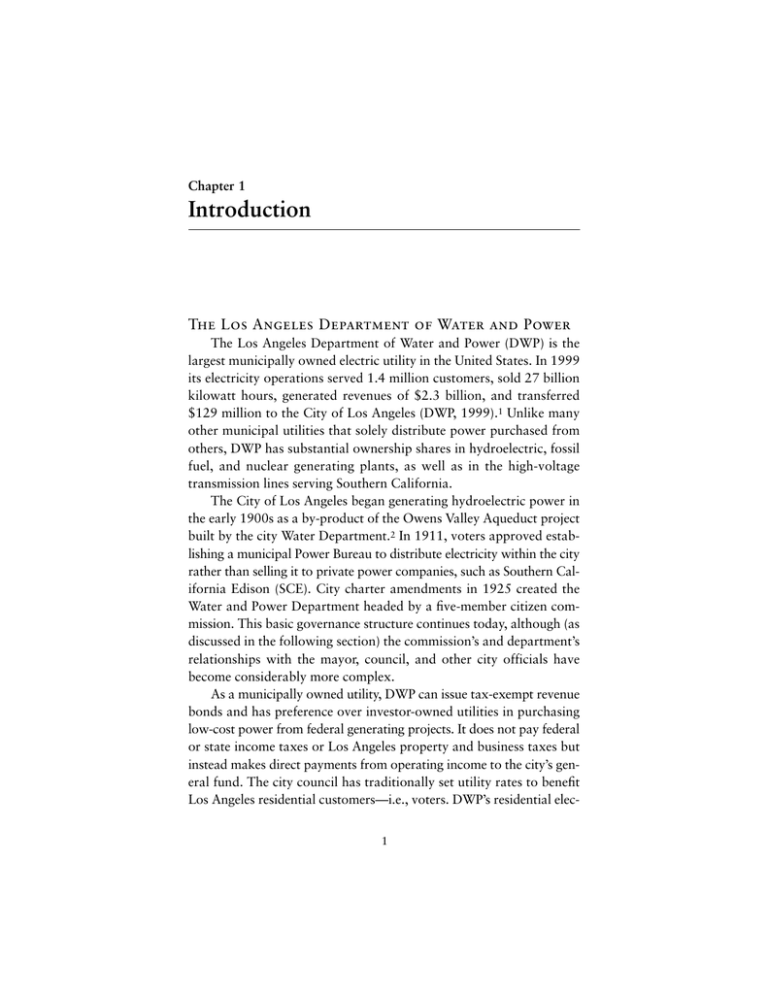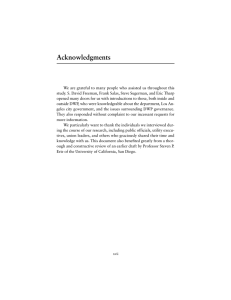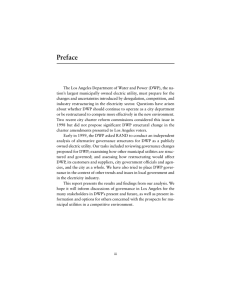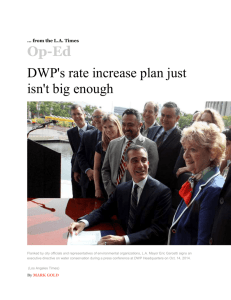Introduction The Los Angeles Department of Water and Power
advertisement

Chapter 1 Introduction The Los Angeles Department of Water and Power The Los Angeles Department of Water and Power (DWP) is the largest municipally owned electric utility in the United States. In 1999 its electricity operations served 1.4 million customers, sold 27 billion kilowatt hours, generated revenues of $2.3 billion, and transferred $129 million to the City of Los Angeles (DWP, 1999).1 Unlike many other municipal utilities that solely distribute power purchased from others, DWP has substantial ownership shares in hydroelectric, fossil fuel, and nuclear generating plants, as well as in the high-voltage transmission lines serving Southern California. The City of Los Angeles began generating hydroelectric power in the early 1900s as a by-product of the Owens Valley Aqueduct project built by the city Water Department.2 In 1911, voters approved establishing a municipal Power Bureau to distribute electricity within the city rather than selling it to private power companies, such as Southern California Edison (SCE). City charter amendments in 1925 created the Water and Power Department headed by a five-member citizen commission. This basic governance structure continues today, although (as discussed in the following section) the commission’s and department’s relationships with the mayor, council, and other city officials have become considerably more complex. As a municipally owned utility, DWP can issue tax-exempt revenue bonds and has preference over investor-owned utilities in purchasing low-cost power from federal generating projects. It does not pay federal or state income taxes or Los Angeles property and business taxes but instead makes direct payments from operating income to the city’s general fund. The city council has traditionally set utility rates to benefit Los Angeles residential customers—i.e., voters. DWP’s residential elec1 2 GOVERNANCE IN A CHANGING MARKET tricity rates today are about 11 percent lower than those of SCE, its forprofit neighbor, while its industrial and commercial rates are about 15 percent higher (DWP, 1999; Edison, 1999). DWP’s reputation as a reliable and efficient electricity supplier has played an important role in the growth of Los Angeles for most of this century. However, it now faces major challenges as competition in the electricity sector comes to California. Electric Utility Deregulation and Restructuring in California Electricity is following a path similar to the experiences of the telephone and gas industries in the 1980s and 1990s: deregulation, competition, and restructuring. Electric utilities in the United States have historically been vertically integrated, regulated monopolies that control all aspects of electricity supply and distribution. Under pressure from regulators and customers for lower costs and greater choice, however, the monopoly structure is crumbling. In electricity, restructuring takes the form of separating the three components of electricity supply: generation, transmission, and local distribution. Generation becomes a fully competitive market. With deregulation of the generation component, customers can buy electricity—whether from a faraway coal power plant or a nearby gas turbine—from suppliers other than their local utility. This is usually referred to as “direct access” competition. Transmission from the power source to the local distributor becomes a separate industry sector regulated by an Independent System Operator (ISO). Distribution to the customer generally remains a monopoly service provided by a local utility regulated primarily by the state Public Utilities Commission. California leads most other states in deregulating and restructuring the investor-owned utility (IOU) sector that serves about 70 percent of the state’s electricity customers. Restructuring is mandated by Assembly Bill (AB) 1890, which became law in September 1996. SCE and other California IOUs began offering competitive direct access to their customers on April 1, 1998. AB 1890 created a California Power Ex- INTRODUCTION 3 change (CalPX), providing a spot market for electricity sales and purchases, and it required IOUs to make their high-voltage transmission facilities available on a fair and equitable basis under the supervision of the new California ISO. With electricity prices determined by the market, some generating plants can no longer compete economically and must be taken out of service before they are fully depreciated. AB 1890 permitted IOUs to recover such “stranded investments” through special “competition transition charges” levied on customers through March 31, 2002. Choices for Los Angeles and DWP Under Deregulation AB 1890 mandated restructuring and direct access competition only for the IOUs. The municipally owned utilities, which serve 30 percent of the state’s customers, are not required to offer direct access competition or to participate in the CalPX and ISO. However, each city council or other utility-governing body must hold public hearings and then make a formal decision on whether or not to open its market and give utility customers direct access to competitive suppliers. In November 1997, at the request of the mayor and city council, DWP’s new general manager, S. David Freeman, prepared an “Action Plan to Meet the Competitive Challenge.” It included proposals to freeze residential rates, downsize the workforce, pay down debt, and take other measures to reduce operating costs (DWP, 1997). These programs have largely been implemented. DWP has reorganized into business units for generation, transmission, and distribution. It joined the CalPX in December 1998. By 2003, the department expects to have paid down all or most of its debt on generating plants that might represent “stranded costs” under competition.3 At that point, DWP would be better prepared to compete with SCE and other electricity suppliers if the council decided to open the Los Angeles market.4 But is DWP, organized as a city department and subject to all the checks and balances of city governance, lean and agile enough to succeed in a competitive market? Does competition require restructuring the present governance system set forth in the city charter? In his re- 4 GOVERNANCE IN A CHANGING MARKET marks to the Los Angeles Charter Reform Commission in March 1998, General Manager David Freeman argued that restructuring is necessary to increase the tempo of decisionmaking at DWP and cut bureaucratic delay (Charter Reform Commission, 1998b). As he elaborated in a subsequent interview: “The current structure is designed to control a monopoly. . . . if you deregulate my competitors and allow them to make deals with my customers on a daily basis . . . I can’t compete as long as the monopoly controls continue to exist.” (Metro, 1998.) Others, in and out of city government, have been less convinced. The charter reform measures approved by Los Angeles voters in June 1999 made only minor adjustments to the DWP governance structure. And the Los Angeles City Council has not yet formally addressed the question of opening the city to direct access electricity competition. Study Purpose and Approach—Outline of This Report At DWP’s request, this study was undertaken in April 1999 to examine DWP governance issues in the context of electricity deregulation and restructuring and alternative structures for governing DWP as a municipally owned utility. The study explicitly did not consider the privatization or sale of DWP electric power operations or of its generating and transmission components.5 The analysis included • a literature review on electricity deregulation, restructuring, and competition in the United States, United Kingdom, and other countries; • a review of AB 1890 and other state and federal legislation and regulations affecting electricity deregulation, restructuring, and competition in California; • a review of DWP governance issues raised by the Los Angeles Charter Reform Commissions (Charter Reform Commission, 1998a; Elected Charter Reform Commission, 1998a, 1998b, 1998c, and 1998d);6 and in other previous studies (Metzler, 1990; Barrington-Wellesley, 1994; Beck, 1996a; and PSC, 1996); INTRODUCTION 5 • interviews with current and former DWP managers; current and former Water and Power Commissioners; city council members and staff; mayor’s office, city administrative officer (CAO), chief legislative analyst (CLA), and city department staff; labor and business leaders; and academics, attorneys, consultants, journalists, and other knowledgeable Los Angeles stakeholders; and • interviews with executives of other municipal and investorowned utilities in the United States and Canada. Chapter 2 describes the current DWP governance structure and the changes that will take effect next year under the new city charter amendments. Chapter 3 discusses DWP decisionmaking and operational problems under the current structure and suggests how competition may exacerbate or otherwise affect them. Chapter 4 then outlines other municipal utility structures in the United States and Canada and compares them with DWP. Three preferred options for modifying or restructuring DWP governance are presented in Chapter 5, followed by a short final chapter outlining some next steps toward deciding how DWP will be structured and governed in the twenty-first century.





